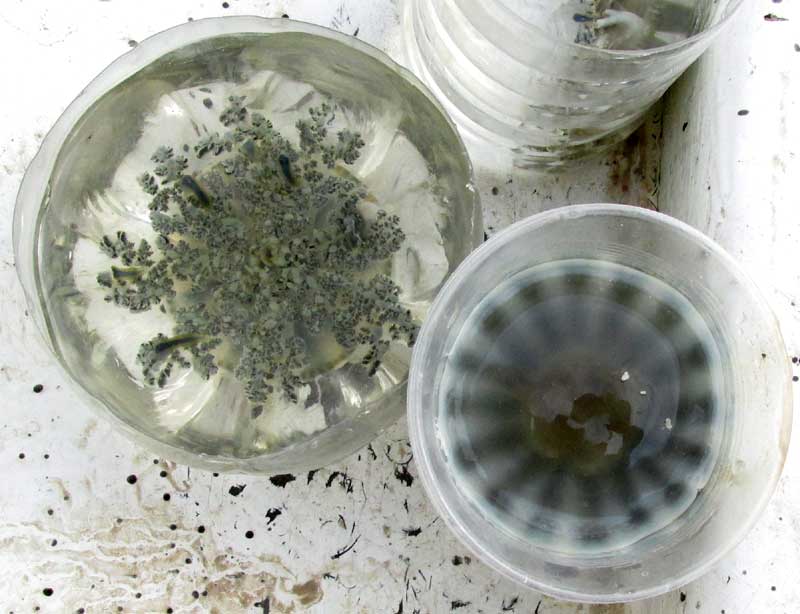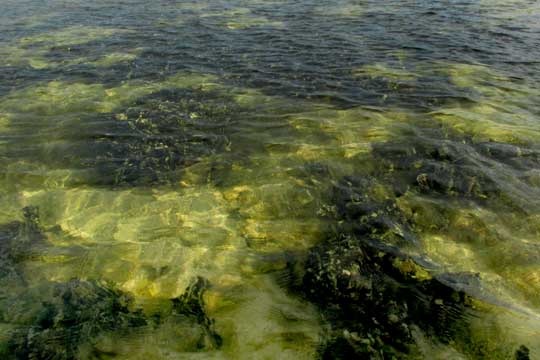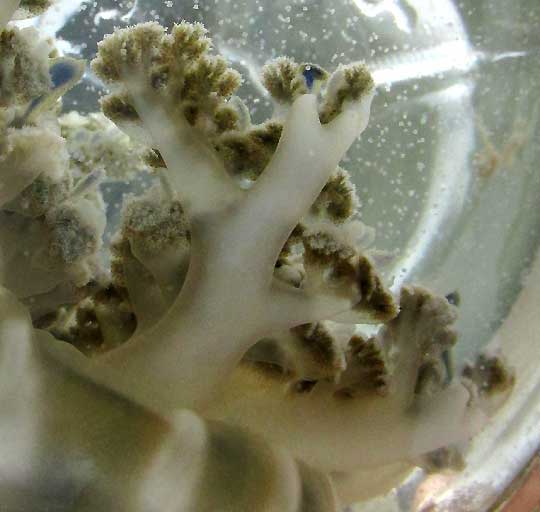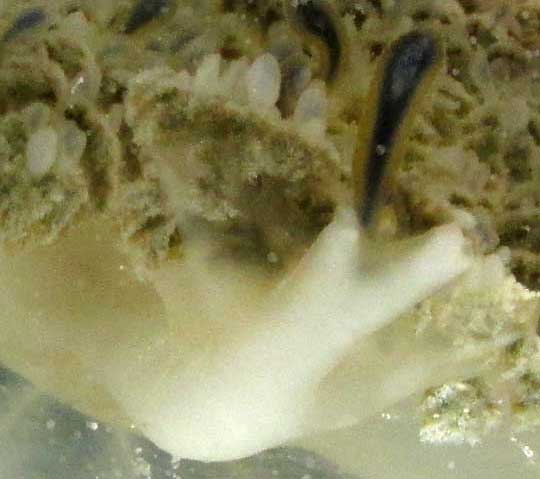Excerpts from Jim Conrad's
Naturalist Newsletter

from the November 23, 2014 Newsletter issued from Río Lagartos, on the Yucatan Peninsula's northern coast (~N21.60°, ~W88.16°), Yucatán state, MÉXICO
UPSIDE-DOWN JELLLYFISH
Much of the Ría Lagartos estuary that mostly surrounds the town of Río Lagartos is only knee deep or less at low tide. In a shallow area where the boat motor had to be tilted up so as to not cut into the mud, and where seaweed grew in patches with open mud between them, Diego, a son of my host Diego Nuñez, pointed out to me a small blob I'd never have noticed without his help. Below, you can see the patch of estuary shallows with the well camouflaged object:

The object was a jellyfish, but one unlike any I'd seen. The entire area was populated with them, some thumbnail-size but others 9cm or more across (3½ inches). At the top of this page you can see a couple in water-filled containers.
In terms of how jellyfish normally present themselves, the larger one at the left is upside-down, the way it normally is on the estuary's mud floor. The one at the right is right-side-up displaying its "umbrella," or "bell," but after floating that way a few minutes slowly it turned itself so that its umbrella lay against the floor. Notice that the umbrella of the one on the right is depressed like the center of a suction cup. As the jellyfish lies on the estuary floor gently pulsating, the depression helps it stay on the bottom by providing something of a suction effect.
That day as we floated in the shallows looking for jellyfish we were lucky enough to have Wili Cruz along, a genuine biologist, who saved me the trouble of identifying our jellyfish by telling me outright that it was CASSIOPEA XAMACHANA, usually referred to simply as the Upside-down Jellyfish.
We think of jellyfish as floating in water or at the water's surface, dangling slender tentacles from their bodies. In the Upside-down Jellyfish's case the tentacles consist of eight thick, elaborately branched "oral arms," which are projected upwards from the jellyfish on the left in the above picture. The arms, as with other jellyfishes, are covered with "nematocysts," which are cell-like structures from which stinging hairs are shot when the nematocyst is stimulated. These stinging hairs are used in self defense and for immobilizing tiny prey. A close-up of an oral arm's nematocyst-covered branches is shown below:

In the first picture you may have noticed a few dark, club-shaped, flattened items arising from the oral arms. These are "vesicular appendages," of which the number, size, and color vary with sex and age. On the Internet pictures can be found of large ones bearing dozens of vesicular appendages. Amazingly, the function of vesicular appendages isn't well understood. Below, you can see a close-up of one, looking like a parasitic leech

Normal jellyfish use their tentacles to conduct prey into their mouths, which open into a stomach-like "gastrovascular cavity" inside the organism. The Upside-down Jellyfish goes a step further: During the course of evolution its central mouth has closed, but many "secondary mouths" have arisen at the ends of branches of the eight oral arms.
Upside-down Jellyfish don't entirely rely on prey for their food, for the organism's body is filled with thousands of "zooxanthellae," which are microscopic, yellow-green or yellow-brown algae who live symbiotically in the jellyfish's cytoplasm, providing the jellyfish with oxygen and sugars the alga photosynthesizes, in the process using some of the jellyfish's waste products, all in exchange for a cozy place to live.
Jellyfish life cycles are complex. The item in our photos is the medusa, or adult stage. Cassiopea xamachana is "dioecious," which means that the medusas come in male and female flavors. Beyond that, things get too complex to go into detail about here. The life cycle is described in detail at http://animaldiversity.ummz.umich.edu/accounts/Cassiopea_xamachana/.